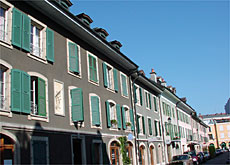Carouge reveals its master crafts and secret gardens

It may live in the shadow of Geneva, but the town of Carouge has its own distinctive and independent character.
Just ten minutes ride from the bustle of the city, visitors stumble on a uniquely “Mediterranean” corner of Switzerland.
“If Geneva is an elegant, worldly-wise lady, then Carouge is the cheeky boy that everyone loves,” says Gianna Mestermann, who organises themed guided tours through Carouge’s distinctive streets.
If it is a cheeky boy, he is wearing his Sunday best.
Carouge has been described as Geneva’s Greenwich Village, though that refers less to a thriving Bohemian scene and more to the fact that it is a refreshing alternative to the city two kilometres to the north.
Discoveries around every corner
Small and compact, crammed with bistros, the workshops of craftspeople, fountains and secret gardens, the old centre of Carouge was made to be strolled around – at as sedate a pace as possible.
As the Swiss writer Henri Tanner put it: “Discovering Carouge is like discovering wild strawberries or mushrooms.”
He was right: seemingly around every corner, there is an unexpected pleasure waiting to be uncovered.
Getting here from Geneva’s city centre could not be easier. Several tram and bus lines cross the River Arve, for centuries the political, as well geographic, boundary that separated Protestant Geneva from Catholic Savoy.
Indeed, Carouge’s past – which essentially amounts to less than 250 years – has much to tell us about the history of its larger neighbour.
In 1754, Geneva’s rulers agreed to give up Carouge, which became part of the Piedmont-Sardinian kingdom, the name by which the House of Savoy became known.
Piedmont look
The Sardinian king Victor-Amadeus III set about developing Carouge as a rival to Geneva.
It was felt that after failing to defeat the Protestants by force, they might be overwhelmed by commerce.
Carouge was one of two towns he sought to develop at either extremity of his realm. The other was Nice.
Italian architects were drafted in to design Carouge, and little by little, the Savoyard village was transformed into a Piedmontese town.
The rows of distinctive two- or three-storey houses that were built in the late 18th Century remain one of Carouge’s biggest attractions.
Just as when they were built, these buildings remain the workshops of artisans, many of them famous locally: the clothes designers Christa and Anne-Claude Virchaux, the floral sculptures of Les Cinq Sens or the clock-maker Jean Kazes work alongside jewellers, milliners, antique furniture restorers and canton Geneva’s only feminist bookshop.
One of the features of Carouge’s houses is the wooden balconies that overlook hidden internal gardens and courtyards, some of which can be visited by the public.
Carillon
What Carouge lacks in large, public parks, it makes up for in the intimacy these private spaces.
“Already the architecture in Carouge is different,” says Mestermann. “But behind, there is an unsuspected universe.”
The gardens are the theme of one of a number of guided tours of Carouge organised by the town council.
Others look at the evocative street names, or visit landmarks like the baroque Sainte-Croix church, whose bell tower contains the largest carillon – a set of 36 tuned bells – in Switzerland.
Carouge was not only a commercial centre. It was, Mestermann says, “an open, tolerant city”, where not only Catholics, but also disaffected Protestants and – unusually for the time – Jews were encouraged to settle.
Indeed, Carouge is home to one of Switzerland’s oldest and best-known Jewish cemeteries.
Today’s understated charm masks the fact that Carouge was once a magnet for citizens of puritan Geneva seeking hedonistic thrills.
Singing, dancing, the theatre, alcohol and contraband goods were either banned or frowned upon, and the Genevese would secretly cross the Arve in search of fun.
“It’s important to know about this history, it helps us to understand the spirit of Carouge,” says Mestermann.
In 1816, after more than 20 years as a strategic French outpost, Carouge was incorporated into canton Geneva – to the displeasure of locals, who, rather than celebrate the Swiss national day, preferred to keep their shutters closed in protest.
Today, the Carougois are happy to deck their squares with patriotic bunting on August 1. But the feeling remains: this is no ordinary corner of Switzerland.
swissinfo, Roy Probert
Geneva’s rulers gave up Carouge in 1754 to the Piedmont-Sardinian kingdom.
Italian architects drafted in to design Carouge.
In former times, disaffected Protestants and Jews settled in town.
With its trendy bistros and crafts shops, the Genevan neighbourhood of Carouge is worth visiting while in the city.
It developed independently from Geneva when it belonged to the Piedmont-Sardinian kingdom.
The rows of distinctive two- or three-storey Piedmontese style houses remain one of Carouge’s biggest attractions.

In compliance with the JTI standards
More: SWI swissinfo.ch certified by the Journalism Trust Initiative
You can find an overview of ongoing debates with our journalists here . Please join us!
If you want to start a conversation about a topic raised in this article or want to report factual errors, email us at english@swissinfo.ch.